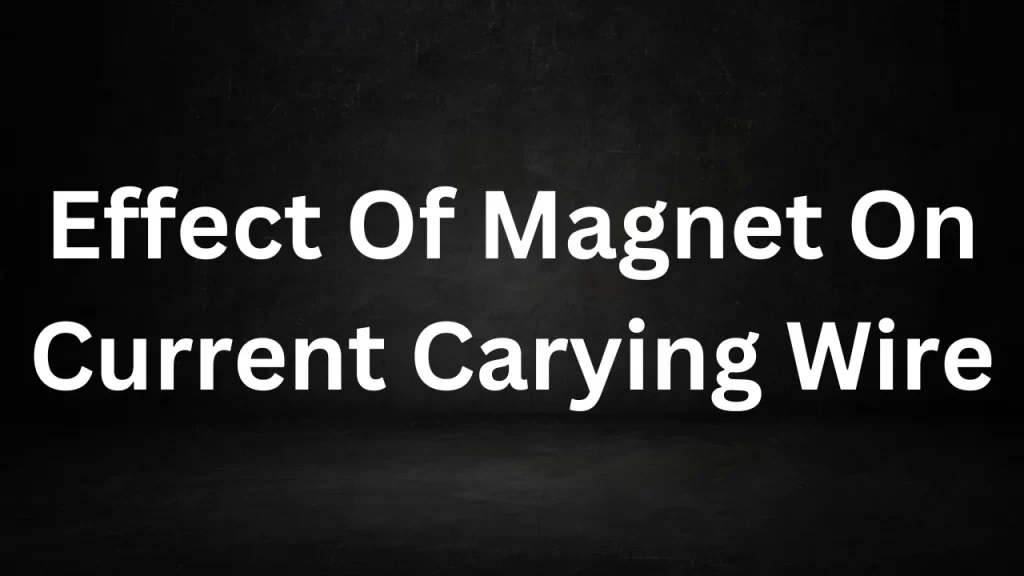Tag: oersted magnet
Oersted Experiment Class 10
Oersted Experiment Class 10: In the world of science, discoveries and experiments have often paved the way for groundbreaking revelations. One such experiment that holds immense significance in understanding the interplay between electricity and magnetism is the Oersted Experiment.
This experiment, named after the Danish physicist Hans Christian Oersted, was a pivotal moment in the history of physics. For Class 10 students, it serves as an excellent example to comprehend the fundamental principles of electromagnetism.

Oersted Experiment Class 10
The Background of the Oersted Experiment
In the early 19th century, scientists were still unraveling the mysteries of electricity and magnetism. The prevailing belief was that these two phenomena were entirely separate and unrelated. However, Oersted questioned this assumption and embarked on an experiment that would change the course of science.
The Experiment Setup
- Equipment: To perform the Oersted Experiment, you’ll need a few simple items: a straight wire, a compass needle, and a battery or electric current source.
Procedure:
a. Secure the wire so that it is parallel to the surface of a table or another stable surface.
b. Place the compass needle near the wire but not touching it.
c. Complete the circuit by connecting the wire to a battery or a power source to allow current to flow through it.
The Unexpected Observation
As the electric current flowed through the wire, something extraordinary happened. The compass needle, initially pointing in a specific direction, deflected from its original orientation. Oersted observed that the compass needle moved and aligned itself perpendicular to the wire carrying the current.
Significance and Implications
Oersted’s experiment had profound implications:
- Establishment of Electromagnetism: The Oersted Experiment provided irrefutable evidence that there was a connection between electricity and magnetism. It shattered the prevailing notion that these forces were entirely separate, ushering in the era of electromagnetism.
- Electromagnetic Fields: The experiment introduced the concept of electromagnetic fields. The magnetic field generated by the current in the wire caused the compass needle’s deflection. This discovery laid the foundation for understanding how electric currents generate magnetic fields.
- Magnetic Effect of Electric Current: The deflection of the compass needle showcased the magnetic effect of an electric current. This phenomenon is now described by Ampere’s law, which quantifies the magnetic field produced by a current-carrying conductor.
Teaching Class 10 Students
The Oersted Experiment is an excellent educational tool for Class 10 students studying physics. It offers several learning opportunities:
- Conceptual Understanding: It helps students grasp the fundamental relationship between electricity and magnetism, a key concept in their physics curriculum.
- Experimental Skills: The experiment introduces students to practical laboratory work, reinforcing their scientific method skills.
- Historical Perspective: Learning about Oersted’s experiment adds historical context to the study of science, demonstrating how scientific knowledge evolves through experimentation.
Conclusion
The Oersted Experiment is a cornerstone in the study of electromagnetism. It transformed our understanding of the fundamental forces governing our universe and has paved the way for countless technological advancements. For Class 10 students, it serves as an engaging and enlightening introduction to the fascinating world of physics, sparking curiosity and inspiring future scientists and engineers.
Read More
- Sodium Chloride Molecular Weight
- Equivalent Weight Of CaCO3
- Benzoic Acid Molar Mass
- Sulfuric Acid Molar Mass
- Discrete Mathematics For Computer Science
Frequently Asked Questions (FAQs) On Oersted Experiment Class 10
1. What is the Oersted Experiment?
The Oersted Experiment is a physics experiment that demonstrates the relationship between electricity and magnetism. It was conducted by Hans Christian Oersted in the early 19th century and showed that an electric current in a wire can create a magnetic field.
2. Why is the Oersted Experiment important for Class 10 students?
The Oersted Experiment is important for Class 10 students because it helps them understand the fundamental connection between electricity and magnetism, a crucial concept in physics. It also introduces them to experimental techniques and the scientific method.
3. What materials are needed to perform the Oersted Experiment?
To conduct the Oersted Experiment, you will need a straight wire, a compass needle, and a battery or electric current source. You may also require connecting wires and a switch to control the current flow.
4. How is the Oersted Experiment performed?
The experiment involves setting up a wire parallel to a compass needle and passing an electric current through the wire. The deflection of the compass needle indicates the presence of a magnetic field generated by the current.
5. What does the deflection of the compass needle in the Oersted Experiment signify?
The deflection of the compass needle shows that an electric current produces a magnetic field around it. This observation is a fundamental principle in electromagnetism.
Effect Of Magnet On Current Carying Wire
Effect Of Magnet On Current Carying Wire: The interaction between magnets and electric currents is a fascinating aspect of electromagnetism, a fundamental branch of physics. This interaction has led to the development of various technological applications, from electric motors to generators.
In this article, we will explore the intriguing effect of magnets on current-carrying wires, shedding light on the principles behind it and its real-world applications.

Effect Of Magnet On Current Carying Wire
The Basics of Electromagnetism
Electromagnetism is a branch of physics that deals with the relationship between electric currents and magnetic fields. It was James Clerk Maxwell who, in the 19th century, formulated the fundamental equations that describe how electric charges and currents generate magnetic fields and how changing magnetic fields induce electric currents.
The Right-Hand Rule
One of the key principles in understanding the interaction between magnets and current-carrying wires is the right-hand rule. This rule states that if you point your thumb in the direction of the current flow (conventional current, from positive to negative), and you curl your fingers, the direction in which your fingers curl represents the direction of the magnetic field lines around the wire. The strength of the magnetic field depends on the current intensity and the distance from the wire.

The Effect of Magnets on Current-Carrying Wires
When a magnetic field interacts with a current-carrying wire, several important phenomena occur:
- Magnetic Force: The magnetic field exerts a force on the wire. This force is perpendicular to both the current direction and the magnetic field direction and is described by the magnetic force formula: F = I * B * L * sin(θ), where F is the force, I is the current, B is the magnetic field strength, L is the length of the wire in the field, and θ is the angle between the current and magnetic field directions.
- Lorentz Force: The magnetic force on the wire is part of the larger Lorentz force, which includes the electric force on charged particles within the wire. This combined force can cause the wire to move or experience a torque.
Applications of the Effect
- Understanding the effect of magnets on current-carrying wires has a multitude of practical applications:
- Electric Motors: Electric motors utilize the interaction between magnetic fields and current-carrying wires to convert electrical energy into mechanical motion. This principle is at the core of various appliances and machines.
- Generators: In generators, mechanical motion is used to move wires through magnetic fields, inducing electric currents. This process is how electrical energy is generated in power plants.
- Magnetic Sensors: Magnetic sensors and compasses rely on the interaction between magnetic fields and current in coils to detect and measure magnetic fields, providing critical information in navigation and various industries.
- Transformers: Transformers use the principles of electromagnetic induction to change the voltage levels in electrical circuits, making power distribution and voltage conversion efficient.
Conclusion
The effect of magnets on current-carrying wires is a fundamental aspect of electromagnetism with profound implications in modern technology. It enables the creation of electric motors, generators, sensors, and transformers, all of which are integral to our daily lives. By harnessing the principles of electromagnetism, scientists and engineers have revolutionized the way we generate, distribute, and use electrical energy, making the world of technology and innovation possible. Understanding these principles is crucial for anyone interested in the fields of physics and electrical engineering.
Read More
- Simple Harmonic Motion Formulas
- Dipole Uniform Magnetic Field
- Light Filtering Polaroid Films Polarization
- Animals Biology Science Lion Zoology
- Difference Between Voltage And Current
Frequently Asked Questions (FAQs) Effect Of Magnet On Current Carying Wire
Q1: What is the basic principle behind the interaction between magnets and current-carrying wires?
A1: The basic principle is that a magnetic field exerts a force on a current-carrying wire. This force is perpendicular to both the current direction and the magnetic field direction and is described by the magnetic force formula.
Q2: What is the right-hand rule in electromagnetism?
A2: The right-hand rule is a convention used to determine the direction of magnetic field lines generated by a current-carrying wire. If you point your right thumb in the direction of the current, the curling of your fingers represents the direction of the magnetic field lines around the wire.
Q3: How does the strength of the magnetic field affect the force on a current-carrying wire?
A3: The strength of the magnetic field (denoted as B) directly affects the force (F) experienced by the wire. The greater the magnetic field strength, the stronger the force on the wire, assuming other factors like current and length remain constant.
Q4: What is the Lorentz force, and how does it relate to the effect of magnets on current-carrying wires?
A4: The Lorentz force is the combined force acting on a charged particle due to both an electric field and a magnetic field. In the context of current-carrying wires, it includes the magnetic force on the wire as well as the electric force on the charged particles (electrons) within the wire.
Q5: What are some practical applications of the effect of magnets on current-carrying wires?
A5: Some practical applications include electric motors, generators, magnetic sensors, compasses, and transformers. These devices rely on the interaction between magnetic fields and current-carrying wires to perform various functions, such as generating electricity, providing directional information, and converting electrical energy into mechanical motion.